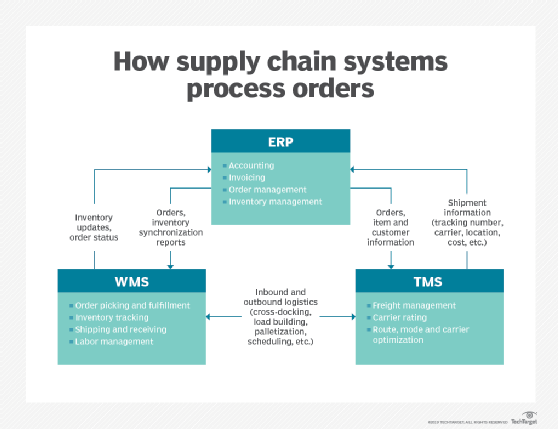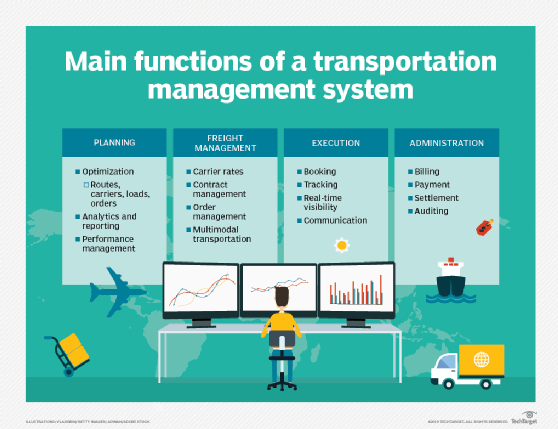
transportation management system (TMS)
What is a transportation management system (TMS)?
A transportation management system (TMS) is specialized software for planning, executing and optimizing the shipment of goods. Users perform three main tasks in a TMS: Find and compare the rates (prices) and services of carriers available to ship a customer's order, book the shipment and then track its movement to delivery.
The broader goals of using a TMS are to improve shipping efficiency during the movement of goods, reduce costs, increase profitability, gain real-time supply chain visibility and ensure customer satisfaction.
Who uses transportation management systems?
Shippers and carriers are the primary users of TMS software. Manufacturers, distributors, e-commerce organizations, wholesalers, retailers and third-party logistics service providers (3PLs) are also major users of TMS software.
A TMS is one of the core technologies used in supply chain management (SCM), a discipline that encompasses supply chain execution (SCE) and supply chain planning (SCP). TMSes are available as standalone software or as modules within enterprise resource planning (ERP) and SCM suites.
This article is part of
Guide to supply chain management
While some TMSes focus on a single mode of transportation, most systems support multimodal and intermodal transportation. In multimodal, a single carrier uses at least two modes of transportation -- truck, rail, air or sea -- and is legally liable for meeting the terms of the contract, though it might hire subcarriers. Intermodal transportation refers to shipments that require more than one carrier and contract. It gives shippers more control over carriers, dispatching, prices and modes of transportation but makes them more responsible for managing the process. Support for international transportation is also an important capability for TMSes.
How transportation management systems work
Fundamentally, a TMS is a repository of detailed information about carriers, but it is also a transactional and communication system that enables users to plan, execute and track shipments. To do all of those things, it must have strong integration with carrier management systems and data sources or some way to download carrier information. It must also facilitate entry of the customer orders that specify what is to be shipped.
Usually, orders come in automatically from ERP or order management systems that are integrated with the TMS. A TMS will sometimes be integrated with a warehouse management system (WMS) to enable better coordination of the tasks that occur at the interface of warehouses and freight shippers, such as procurement, palletization of goods, labor scheduling, yard management, load building and cross-docking.
The three main SCM systems -- ERP, WMS and TMS -- each have important but largely distinct roles to play in processing orders. Integration among the three enables them to share certain types of data and standard documents that are necessary for getting the right products to customers on time as efficiently as possible (see Figure 1).

Each of the three main SCM systems in Figure 1 has a particular role in managing orders and sharing data with the other two. The TMS manages the data and processes relating to the transporting of goods.
Following is a brief summary of what ERP systems and WMSes do and how the ERP system relates to a TMS.
The ERP system handles the accounting and most of the invoicing, order management and inventory management. The WMS' role is to help users manage the fulfillment, shipping and receiving tasks in the warehouse or distribution center, such as picking goods from shelves for shipment or putting received goods away. Its role in inventory is to track the inventory data that comes in from barcode readers and radio frequency identification (RFID) tags and update the inventory management module in the ERP system to ensure it has the latest information. An integration link synchronizes the inventory data in the ERP system and the WMS.
The ERP system outputs the order information the TMS needs to prepare and execute shipments. Besides the basics -- like customer name and address -- the data stream from the ERP system also includes detailed item information to ensure the right products are shipped. The TMS returns the shipment details that the ERP system needs for its accounting and order management functions, such as the tracking number, carrier name and costs. The TMS can also wirelessly communicate information relating to items in a driver's vehicle so the driver can update shipment data when a delivery has been completed. The shipment information might also go to a customer relationship management (CRM) module so the sales and customer service departments can update customers about the status of their orders.
Importance of a transportation management systems
A TMS is a necessity for any company with direct responsibility for transporting a significant volume of goods or hiring service providers to do the job. The complexities of today's supply chains, transport modes and regulations make the task nearly impossible without computerization.
Automation of these complex processes helps ensure that transportation services are secured as inexpensively as possible without a loss of quality or efficiency. Experience has shown that savings associated with transportation costs can be effectively managed and reduced. More importantly, the customer experience can be improved when data from the TMS is sent to an ERP or CRM system that provides the customer with timely shipment status.
Transportation management systems and the supply chain
TMSes play a central role in supply chains. SCM is the process of planning, controlling and executing the flow of a product through the various stages of its lifecycle, from raw materials to production and distribution. Transportation is usually required in all of the major steps.
Raw materials, for example, need transporting from their original location -- perhaps a mine or a farm -- to the supplier's processing plant. While the materials' ultimate destination is likely to be a manufacturer, there might be intermediate locations along the way. The manufacturing process itself might require additional shipments if, for example, subassemblies need to be moved between the manufacturer's facilities or to those of a subcontractor.
Distribution of the final product typically requires several steps that may involve more than one mode of transportation. For example, products made in China are typically shipped overseas, then received in a port and placed on trucks. Even the final shipment to the retail store or the customer's home isn't the end of it. In reverse logistics, the product is returned to the distributor or manufacturer for servicing or refurbishment only to be shipped back to the customer or store for resale, or the product might be transported to a recycling facility or landfill.
Transportation management system deployment options
Like most enterprise software systems, TMSes started as on-premises systems but have increasingly been deployed in the cloud as software as a service (SaaS). Managed service providers (MSPs) also offer TMS services.
Running in the cloud has obvious advantages in easing connectivity between TMS users, carriers, customers and supply chain partners. Some TMS vendors try to differentiate themselves by offering single-instance, multi-tenant SaaS, which they say has cost and integration advantages over single-tenant SaaS and private cloud options.
In fact, according to Gartner, most of the growth in the TMS market continues to result from cloud offerings that companies bought to replace on-premises TMS, a trend that is likely to persist. Meanwhile, TMS vendors continue to migrate their products to SaaS, in large part to fend off competition from fast-growing cloud-native vendors who started with SaaS-based TMS.
Though many organizations nowadays prefer to run a TMS in the cloud because of the connectivity advantages and potential savings in IT labor and infrastructure, on-premises deployment is still preferred by some large manufacturing and distribution firms that have stringent security requirements and want day-to-day control of their TMS software. Hybrid arrangements where legacy on-premises systems are supported by cloud-based TMS are also possible.
Functions of transportation management systems
The functions of a typical TMS (see Figure 2) can be loosely grouped into the following categories.
Freight management
A TMS acquires, stores and updates the rates that carriers charge for shipping, often over the internet in real time. Having current rates in one place makes comparisons easier than in the pre-TMS days, when freight managers would have to phone or fax carriers and record rates manually. Instead, relationships with carriers, the rates negotiated with them and delivery times can largely be managed online. The number of carriers in a TMS can reach the tens of thousands.
Other features handle the workflow and paperwork involved in freight management, such as contracts held with individual carriers, and load tendering, which provides the details that carriers need to decide whether to bid on a load and serves as a record of what was agreed to. Some TMSes also support order management, though that function is more commonly done in ERP or separate order management software.

The typical TMS provides a complete set of sophisticated tools for planning, executing and optimizing shipments and has a repository of up-to-date shipping rates for carriers that can number in the tens of thousands.
Execution
A TMS also enables users to execute the major actions of freight management, including booking of shipments with carriers. Real-time visibility into the movement of freight throughout the transportation network makes it possible to track shipments and share that information with customers and suppliers. There are also communication mechanisms for contacting drivers in transit and Global Positioning System (GPS) features for measuring time and distance.
Planning
While most TMS features focus on execution, much of the power of the system comes from the tools it provides for planning and optimizing the shipping process. It provides data and analytics on critical factors, such as price, service level and transit time, to enable users to choose the carriers and routes most likely to transport goods the fastest and cheapest. These optimization capabilities can extend down to the order and load level. Users can, for example, size loads or redirect orders to maximize the use of carrier resources in less-than-truckload (LTL) shipments. They can also plan multileg trips to minimize fuel and labor costs by avoiding empty miles between stops.
A TMS usually has reporting and analytics features for analyzing carrier key performance indicators (KPI) and other important metrics. It can also export data and reports to the ERP system or a business intelligence (BI) platform for analysis.
Administration
Transportation and logistics management are inherently complex endeavors that require substantial paperwork for business-to-business (B2B) transactions, regulatory compliance and auditing. Accordingly, a TMS must have sufficient administrative features to support the documentation and financial reporting requirements. Typical features include billing, payment and tools for ensuring accuracy by comparing a carrier's published rates with the amounts in an invoice, for example. There may be an automatic payment system to minimize handling of invoices. A TMS can also generate a bill of lading, a type of receipt that a shipper or carrier can issue to specify the items in a shipment and the terms of the contract. Bills of lading are also used in customs and insurance.
A TMS must also handle settlement, a more complex process that requires documenting certain freight milestones and metrics before payment can be made, such as proof of delivery, pickup and time in transit. Data collected during the settlement process is used by the TMS' performance management and optimization processes. TMS users can search settlement data for clues to customer demand and capacity utilization and in order to negotiate special pricing for factors such as loading speed and time of day.
Performance data might also be used to verify compliance with Federal and state transportation regulations. This can be important when Federal and state agencies execute surprise inspections, often involving freight audits. It can also be used to demonstrate why one carrier is better than another, based on relevant performance metrics.
Benefits of TMS
Transportation management software can benefit companies in numerous ways, including the following:
- Reduced distribution and warehouse costs through better fleet management, labor and space use, and coordination between the transportation and fulfillment functions.
- Higher customer satisfaction from a more responsive shipping process.
- Supply chain visibility from the ability to track and monitor the lifecycle of orders and shipments in real time.
- Improved inventory management and forecasting thanks to better visibility and accountability in the supply chain network.
- Reduced administrative costs and invoicing errors by automating freight payment and auditing processes.
Challenges of TMS
Owing to the complexity and unique demands made of TMS solutions, a few challenges can be identified and must be addressed during planning, deployment and maintenance.
- Difficulties and costs when transitioning from a legacy TMS to a new platform. Decades-old legacy systems might still perform well, but newer systems are likely to have more features and greater adaptability to changing transportation requirements. Making the transition to a new platform might take a considerable amount of time and cost. It might also require time for the new system to accept data formatted for the legacy system.
- Difficulties interfacing with external systems communicating with motor vehicles and drivers. The ability to link to motor vehicles and drivers is a highly important capability, and a new system might have some challenges linking with existing wireless onboard systems in motor vehicles.
- Difficulties linking to other motor carrier systems. As TMSes might communicate with other motor carrier TMS platforms, the ability to exchange data and other information between systems might be a challenge.
- Challenges complying with federal and state regulations. Achieving compliance with the many regulations in transportation can be a challenge, but the ability to demonstrate compliance is critical.
- Challenges getting employees to accept the new system. This is true whenever a familiar system is replaced with a new one. Encouraging TMS users to accept a new system requires training, patience and a well-thought-out transition plan.
Transportation management system software providers
Vendors of TMS software fall into the following four product categories:
- ERP suites. Microsoft, Oracle and SAP are prominent ERP vendors that offer substantial TMS modules as options in their suites. Other ERP vendors might rely on third-party TMSes that can be integrated with their ERP offerings. Smaller ERP vendors also have distribution modules that handle some TMS tasks but might not be a true TMS.
- SCM suites. Makers of SCM suites typically provide everything but the ERP component. Major players include Blue Yonder (formerly JDA Software Group) and Manhattan Associates, E2open and BluJay (acquired by E2open).
- Niche TMS. MercuryGate, Kuebix and Alpega Group compete with 3Gtms, 3T Logistics, C.H. Robinson (Navisphere), Infor GT Nexus and many others.
- TMS services. Several vendors of TMS software offer managed service versions, among them BluJay, C.H. Robinson, Kuebix and Transplace.
Future of transportation management systems
The rise of omnichannel commerce continues to stimulate demand for TMS technology, as companies look for ways to service a growing number of distribution channels. To meet these needs, a TMS must have good integration with e-commerce sites and the ability to handle single-parcel delivery, as more consumers choose to forego shopping at stores. The trend to use home delivery has continued to grow in popularity since the COVID-19 pandemic, with more people working from home and reducing their trips to stores.
Latest technologies, such as the internet of things (IoT), artificial intelligence (AI) and 5G (fifth-generation) cellular networks, continue to have a significant impact on SCM by improving visibility into the supply chain -- the ability to get timely data on goods at critical junctures along the chain. IoT makes network connectivity and sensors less expensive, which means more data can be collected, increasingly in real time, and from smaller items, such as individual parcels. Advances in networking are also making TMSes available on smartphones and other mobile devices.
AI and machine learning (ML) bolster advanced analytics, bringing new diagnostic and predictive capabilities to TMSes, such as optimized carrier selection and preventive maintenance, all with the goal of continuous improvement of shipping operations. Three-dimensional graphics are becoming more common in visualization tools that help, for example, with designing loads. SaaS continues to provide an important delivery mechanism for these capabilities.
The distributed ledger technology blockchain is likely to impact the design and use of TMS technology. Some observers consider SCM to be the most promising practical application of blockchain, which is designed to provide an efficient and secure way for large numbers of participants to execute transactions and share digital information. In transportation management and logistics, blockchain is expected to make it easier to share trustworthy, detailed data on a wide variety of goods. It could also improve the efficiency of the essential documents used in logistics, from orders to invoices to contracts.
In the time since the pandemic, long-term trends still point to increasing globalization of supply chains. The continued move toward SaaS deployment, use of AI/ML resources, and ubiquitous internet-based devices should have TMS technology streamlined and poised to take on an even bigger role in SCM.
Implementing a transportation management system can be challenging. Explore seven tips for implementing a transportation management system.







